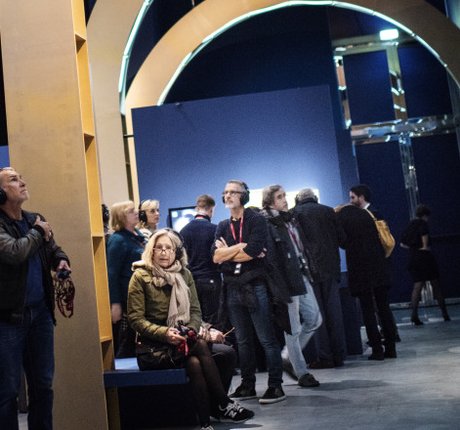Exhibition
•
For all
•
Espace d'exposition - Philharmonie
The Philharmonie de Paris exhibition Marc Chagall: The Triumph of Music explores the artist’s creations for the stage, the décors and architectural works he was commissioned to produce, all somehow tied to music. The show brings together some three hundred artworks (paintings, drawings, costumes, sculptures and ceramics), with multimedia installations featuring the ceiling of the Paris Opera thanks to extraordinary technology developed by Google Lab, and photographs (for the most part previously unpublished), including those of Marc Chagall’s studio taken by Izis in the 1960s.
The panels Chagall painted for the Jewish Theatre in Moscow in 1920, conserved at the Tretyakov Gallery, form a universal décor, encompassing the different arts (Music, Dance, Theatre and Literature) in a “total” approach to art, while celebrating Yiddish culture and language through the amalgam of vernacular theatre, music, rhythm, sound and colour. Later, when Chagall fled Europe for the United States, his discovery of the spaciousness and monumental scale of American architecture and landscapes inspired a new direction in the artist’s works for the stage. He created the scenery and costumes for the ballets Aleko in Mexico in 1942 and The Firebird in New York in 1945, rekindling his connection to Russian music. Chagall eventually returned to France, where the Paris Opera commissioned similar work for Daphnis et Chloé in 1958 (1959 for the Paris Opera premiere). His collaboration with the Paris Opera culminated in 1962 when the presiding Minister of Cultural Affairs André Malraux commissioned Chagall to paint the ceiling of the Palais Garnier Opera House. Inaugurated in 1964, this celebrated work – and the artist’s personal musical pantheon – is a stunning tribute to the composers who have marked the history of music. The many previously unreleased sketches for this project retrace the genesis of the creation step by step, and the various stages in the artist’s creative process. In all of Chagall’s work, music is manifested in a remarkable range of resonances which make our time with his art an enchanting experience.
Scientific curator: Ambre Gauthier
Music director: Mikhaïl Rudy
The panels Chagall painted for the Jewish Theatre in Moscow in 1920, conserved at the Tretyakov Gallery, form a universal décor, encompassing the different arts (Music, Dance, Theatre and Literature) in a “total” approach to art, while celebrating Yiddish culture and language through the amalgam of vernacular theatre, music, rhythm, sound and colour. Later, when Chagall fled Europe for the United States, his discovery of the spaciousness and monumental scale of American architecture and landscapes inspired a new direction in the artist’s works for the stage. He created the scenery and costumes for the ballets Aleko in Mexico in 1942 and The Firebird in New York in 1945, rekindling his connection to Russian music. Chagall eventually returned to France, where the Paris Opera commissioned similar work for Daphnis et Chloé in 1958 (1959 for the Paris Opera premiere). His collaboration with the Paris Opera culminated in 1962 when the presiding Minister of Cultural Affairs André Malraux commissioned Chagall to paint the ceiling of the Palais Garnier Opera House. Inaugurated in 1964, this celebrated work – and the artist’s personal musical pantheon – is a stunning tribute to the composers who have marked the history of music. The many previously unreleased sketches for this project retrace the genesis of the creation step by step, and the various stages in the artist’s creative process. In all of Chagall’s work, music is manifested in a remarkable range of resonances which make our time with his art an enchanting experience.
Scientific curator: Ambre Gauthier
Music director: Mikhaïl Rudy

Espace d'exposition - Philharmonie
See the venueGetting here
Porte de Pantin station
Paris Underground (Métro) Line 5
Tram 3B
Address
221 avenue Jean-Jaurès, 75019 Paris
